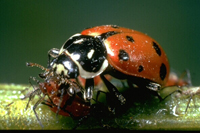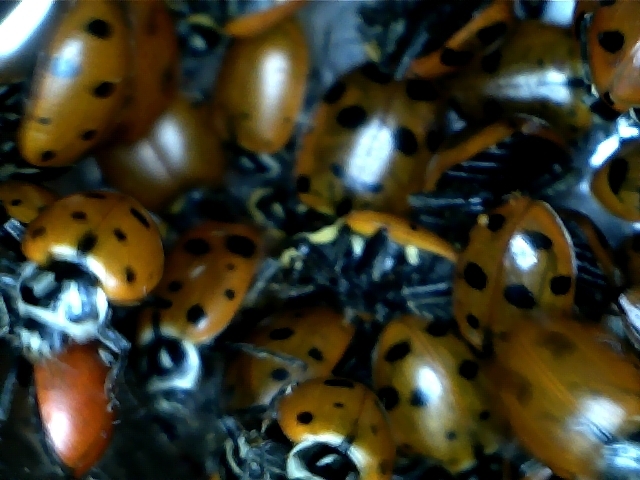
Ladybugs- Hippodamia convergens
Hippodamia convergens or Convergent lady beetle adults and larvae eat aphids and require an aphid diet to lay eggs. When aphid populations are low, they will eat whitefly and some other soft-bodied insects or subsist on pollen and nectar. The convergent ladybug migrates to hibernation sites in mountain valleys where it congregates seasonally. They are collected (not grown at the insectary) in variable and recently declining numbers. So, while valuable in early spring, supplies of ladybugs are often low. As summer approaches, lady beetles can be collected again. Summer beetles disperse quickly unless contained by screening. Plan 1 per sq ft in greenhouses OR ½-1 gal per acre, 1-2 times. Release after dark, while they are cold and slow moving. Sprinkle area with water, place beetles near pests.
Seasonally available--- collected from wild--- Lacewing preferable






Additional Info
The common commercially available ladybug is actually called the convergent ladybird beetle (Hippodamia convergens). They are shipped as adults in cloth bags or containers. They should be released in the early morning or evening hours when they are calm and slow moving. Once warmed up, provide water for rehydration by sprinkling the area. With ample food, light and moisture, along with favorable weather, ladybird beetles can begin reproducing immediately. You may witness several generations in a single growing season. The beetles can be stored for one to three weeks at 40 to 60º Fahrenheit). Allow them to warm to room temperature once or twice per week, sprinkle the bag with water, and allow ladybugs to drink for two hours.
RELEASE RATES
500 ladybird beetles are generally enough for up to 500 square feet of planted area. Use one gallon (72,000) for approximately 10 acres with light to moderate infestation, up to one gallon per acre with heavy infestation.
BIOLOGY
The convergent ladybird beetle feeds on aphids, and also some other pests, such as moth eggs, thrips, and leafhoppers. It is a predator in both adult and larval stages. The yellow eggs are laid on end in clusters of 10 to 50. The alligator-shaped larva is black with orange spots on some of the body segments; it pupates on the upper leaf surfaces. The life span of Hippodamia convergens from egg to adult takes about three to four weeks in summer, six weeks in spring. After the adult emerges from the pupa, it takes five to 13 days before eggs are deposited. Eggs hatch into larvae in about five days. Development time of each stage and reproduction depend on temperatures and amount of available food. The number of eggs laid per adult may range up to about 1,500. One larva will eat about 400 medium sized aphids until it pupates. Over 5,000 aphids may be eaten by a single adult, which can live as long as a year.
BEHAVIOR RELATED TO HOW LONG IN COLD STORAGE
Hippodamia convergens are not reared in insectaries but are collected from overwintering sites. Aggregations are formed in mountain canyons after the beetles have migrated from valley feeding areas. They are refrigerated until sold. Convergent ladybird beetles vary in their dependability as predators with the duration of cold storage. A wise precaution is ordering one gallon or less in order to observe how well they stay put before making a larger purchase. They might migrate before laying eggs if body fat reserves are high (summer and fall collections) or if ovaries are underdeveloped (newly emerging females).
Ladybugs are the only commercial beneficial insects that seem to improve as the result of cold storage. Cold storage gives them time to slowly burn off the body fat used during hibernation so that when you release them they are hungry and less likely to fly away. Suppliers cannot always predict these variables in advance of release, but if they can tell you when the ladybugs were collected and how long they have been stored, you can guess better how well they will stay.
LADYBUGS, LACEWING OR APHIDOLETES: WHICH TO USE?
Some research has suggested that commercial ladybugs collected from overwintering aggregations are not effective predators; however, recent findings confirm the benefits many users observe from the immediate predation and egg-laying of ladybugs when conditions are right. They are especially valuable when you want fully grown predators in a hurry early in the spring before it is warm enough for green lacewing to be active. Green lacewing are a superior predator from the standpoint that the larvae cannot fly and do not disperse and attack large quantities of many pests besides aphids. Aphidoletes aphidomyza, the aphid predatory midges, are another good choice to use against aphids in settings protected from wind and soil tillage, such as orchards and permanent bed landscapes and gardens of perennials, where they colonize and overwinter for years after one release.
OTHER CONSIDERATIONS USING LADYBUGS
Ant management often goes hand-in-hand with using predators like ladybugs. Ants will protect aphids and other honeydew-producing insects, and will attack lady beetles and other beneficial organisms. Pesticides and even wetting agents and spreader-sticker compounds that come with biological materials may adversely affect ladybug survival. Rincon-Vitova sells boric acid baits and MaxForce Granular Ant Bait for ant management. For more ideas on cultural management of ants, see the article “Argentine Ants Must Be Suppressed” and “Ant Management Products”.
HANDLING AND RELEASE
Convergent ladybird beetle (Hippodamia convergens) are shipped as adults in cloth bags or containers. The beetles can be stored for one to three weeks at 40-60º F. Allow them to warm to room temperature once or twice per week, sprinkle the bag with water, and allow ladybeetles to drink for about 2 hours then return to the storage in a refrigerator. They should be released in the early morning or evening hours when they are calm and slow moving. Once warmed up, provide water for rehydration by sprinkling the area.
Ladybeetles should be released directly on pests, ideally in the evening (or else very early morning or when it is cool or overcast) when they will move more slowly. Misting foliage beforehand may improve performance. With ample food and moisture, ladybird beetles can begin reproducing immediately. You may witness several generations in a single growing season
